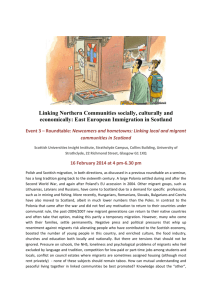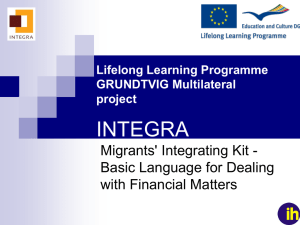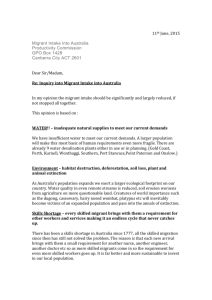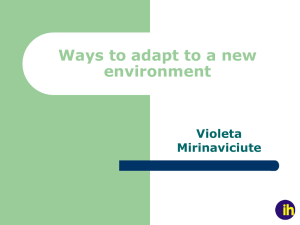doc
advertisement
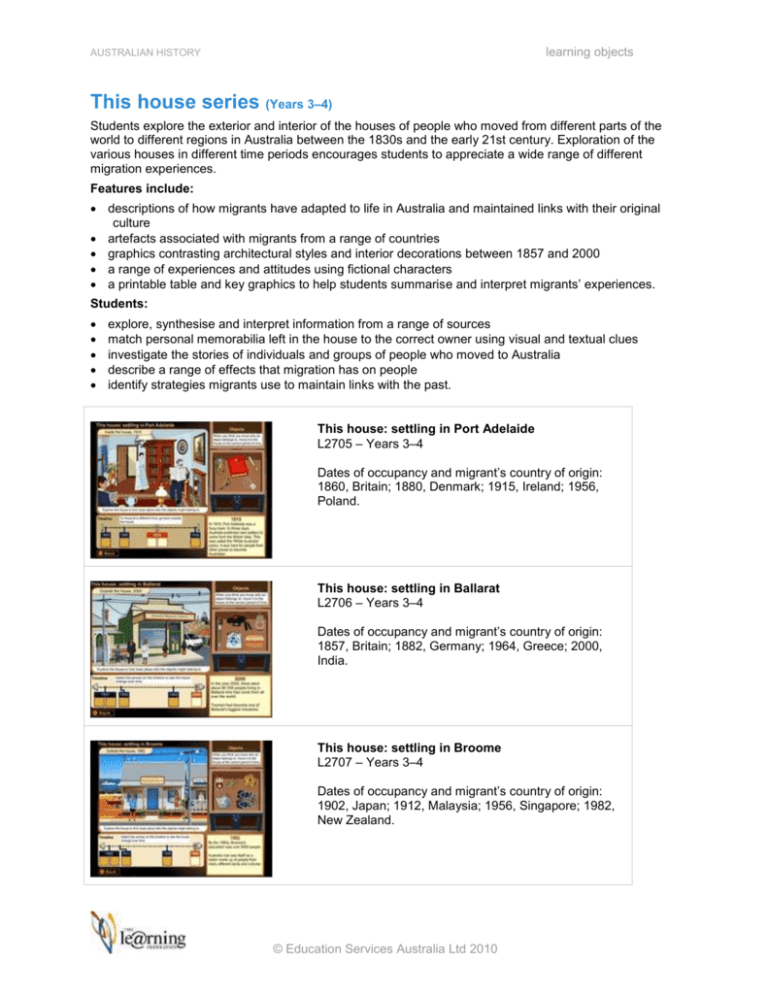
learning objects AUSTRALIAN HISTORY This house series (Years 3–4) Students explore the exterior and interior of the houses of people who moved from different parts of the world to different regions in Australia between the 1830s and the early 21st century. Exploration of the various houses in different time periods encourages students to appreciate a wide range of different migration experiences. Features include: descriptions of how migrants have adapted to life in Australia and maintained links with their original culture artefacts associated with migrants from a range of countries graphics contrasting architectural styles and interior decorations between 1857 and 2000 a range of experiences and attitudes using fictional characters a printable table and key graphics to help students summarise and interpret migrants’ experiences. Students: explore, synthesise and interpret information from a range of sources match personal memorabilia left in the house to the correct owner using visual and textual clues investigate the stories of individuals and groups of people who moved to Australia describe a range of effects that migration has on people identify strategies migrants use to maintain links with the past. This house: settling in Port Adelaide L2705 – Years 3–4 Dates of occupancy and migrant’s country of origin: 1860, Britain; 1880, Denmark; 1915, Ireland; 1956, Poland. This house: settling in Ballarat L2706 – Years 3–4 Dates of occupancy and migrant’s country of origin: 1857, Britain; 1882, Germany; 1964, Greece; 2000, India. This house: settling in Broome L2707 – Years 3–4 Dates of occupancy and migrant’s country of origin: 1902, Japan; 1912, Malaysia; 1956, Singapore; 1982, New Zealand. © Education Services Australia Ltd 2010 learning objects AUSTRALIAN HISTORY This house: settling in Mackay L6359 – Years 3–4 Dates of occupancy and migrant’s country of origin: 1890, Britain; 1916, Malta; 1951, Netherlands; 1989, Samoa. This house: settling in Darwin L6360 – Years 3–4 Dates of occupancy and migrant’s country of origin: 1963, Greece; 1979, Chile; 1995, Thailand; 2005, Vietnam. This house: settling in Leichhardt L6361 – Years 3–4 Dates of occupancy and migrant’s country of origin: 1885, Ireland; 1926, Italy; 1974, Lebanon; 2005, Tanzania. This house: settling in Ainslie L6362 – Years 3–4 Dates of occupancy and migrant’s country of origin: 1952, Germany; 1968, Britain; 1980, Cambodia; 2002, China. This house: settling in South Hobart L6363 – Years 3–4 Dates of occupancy and migrant’s country of origin: 1838, Britain; 1949, Ukraine; 1958, Netherlands; 2003, Sudan. This series contains non-TLF content. See Acknowledgements in the learning objects. © Education Services Australia Ltd 2010 learning objects AUSTRALIAN HISTORY This house: settling in Leichhardt (ESL) (Years 3–4) Students explore the life stories of a range of people who lived in a house in Leichhardt between 1885 and 2005. They find out where they came from, how they got to New South Wales and what they brought with them. Features include: images of artefacts associated with migrants from a range of countries graphics contrasting architectural styles and interior decorations between 1885 and 2005 illustrations of a range of experiences and attitudes, using fictional characters a printable table and key graphics to help students summarise and interpret migrants’ experiences modified language for English as a Second Language users a glossary of terms used in the activity. Students: explore, synthesise and interpret information from a range of sources investigate the stories of individuals and groups of people who moved to Australia describe a range of effects that migration might have on people identify strategies migrants use to maintain links with the past. This house: settling in Leichhardt (ESL) L9447 – Years 3–4 Students explore how migrants from Ireland, Italy, Lebanon and Tanzania adapted to life in Australia and maintained links with their original culture. This series contains non-TLF content. See Acknowledgements in the learning objects. © Education Services Australia Ltd 2010

